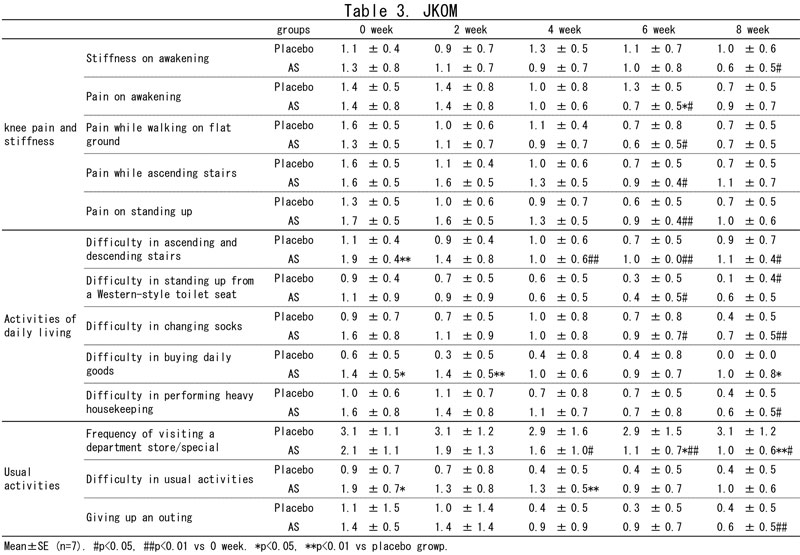- TOP
- List of reports
- The Effect of Acanthopanax senticosus Root Powder-Containing Food on Knee Joint Pain
The Effect of Acanthopanax senticosus Root Powder-Containing Food on Knee Joint Pain
【Scientific information】
Research and Development Department, Sun Chlorella Corporation
The Effect of Acanthopanax senticosus Root Powder-Containing
Food on Knee Joint Pain
Published in the Journal of Japanese Society for Medical Use of Functional Foods (2013)
- Study Objectives
- According to Health Statistics in Japan, 2010, 1,185,000 patients had arthropathy. Knee joint pain in its milder form is associated only with pain at the time of standing up and sitting down along with pain while ascending and descending stairs; however, as the disease progresses walking may become difficult. Drug therapy and exercise therapy are used for the treatment of knee joint pain; however, long-term drug therapy can be associated with adverse reactions, and it is not easy to continue exercise therapy. Therefore, the effects of Acanthopanax senticosus on the symptoms of knee joint pain were investigated.
- Method of experiments
- The subjects (14 men and women with knee joint pain) were randomized to 2 groups of 7 subjects each. The subjects of one group ingested 40 tablets of Acanthopanax senticosus root powder-containing food (20 tablets after both breakfast and supper) for 8 weeks (AS group); the subjects of the other group ingested a placebo following the same regimen (placebo group). During the ingestion period, the subjects exercised to improve symptoms of knee joint pain every day (1 set of exercises consisted of 10 reps of raising the knees and holding the position for 6 seconds while sitting on a chair; 3 sets of exercises were performed daily). At the start of ingestion (0 week) and at 8 weeks after the start of ingestion, a test was conducted to determine the extent of knee joint bending (passive knee joint range of motion test). At the start of ingestion and every 2 weeks thereafter, questionnaires to determine the degree of knee pain, quality of life (QOL), and so on (visual analog scale [VAS] and Japanese Knee Osteoarthritis Measure [JKOM]) were conducted 5 times.
- Results
- The results of the passive knee joint range of motion test showed that the subjects of AS group showed a significant increase in range of motion at 8 week compared with the value at 0 week.
The VAS questionnaire demonstrated that the subjects of AS group experienced a significant decrease in knee pain while walking at 4 week; further, the questionnaire showed a significant decrease in knee pain while ascending and descending stairs at 6 week and 8 week compared with the values at 0 week.
The JKOM questionnaire indicated that the subjects showed an improvement in the symptoms of "knee pain and stiffness" (stiffness on awakening, pain on awakening, pain while walking on flat ground, pain while ascending stairs, and pain at the time of standing up), symptoms related to "activities of daily living" (difficulty in ascending and descending stairs, difficulty in standing up from a Western-style toilet seat, difficulty in changing socks, and difficulty in performing heavy housekeeping), and symptoms related to "usual activities, etc." (frequency of visiting a department
store/special event and giving up an outing).
These results showed that Acanthopanax senticosus alleviates knee joint pain and that it could reduce the risk of locomotive syndrome and improve QOL.



Reference of Journal
- Name of Journal:
- Journal of Japanese Society for Medical Use of Functional Foods, Vol.7 No.5(2013)
- Title:
- The effect of Acanthopanax senticosus Harms on knee joint pain: randomized placebo-controlled trial
- Authors:
- Masako Hoshizaki1、Hideo Takekoshi1、Akira Noro2、Yoshimichi Kohzai2
- Affiliation:
- 1)Sun Chlorella Corporation, 2)New Drug Development Research Center, Inc.





